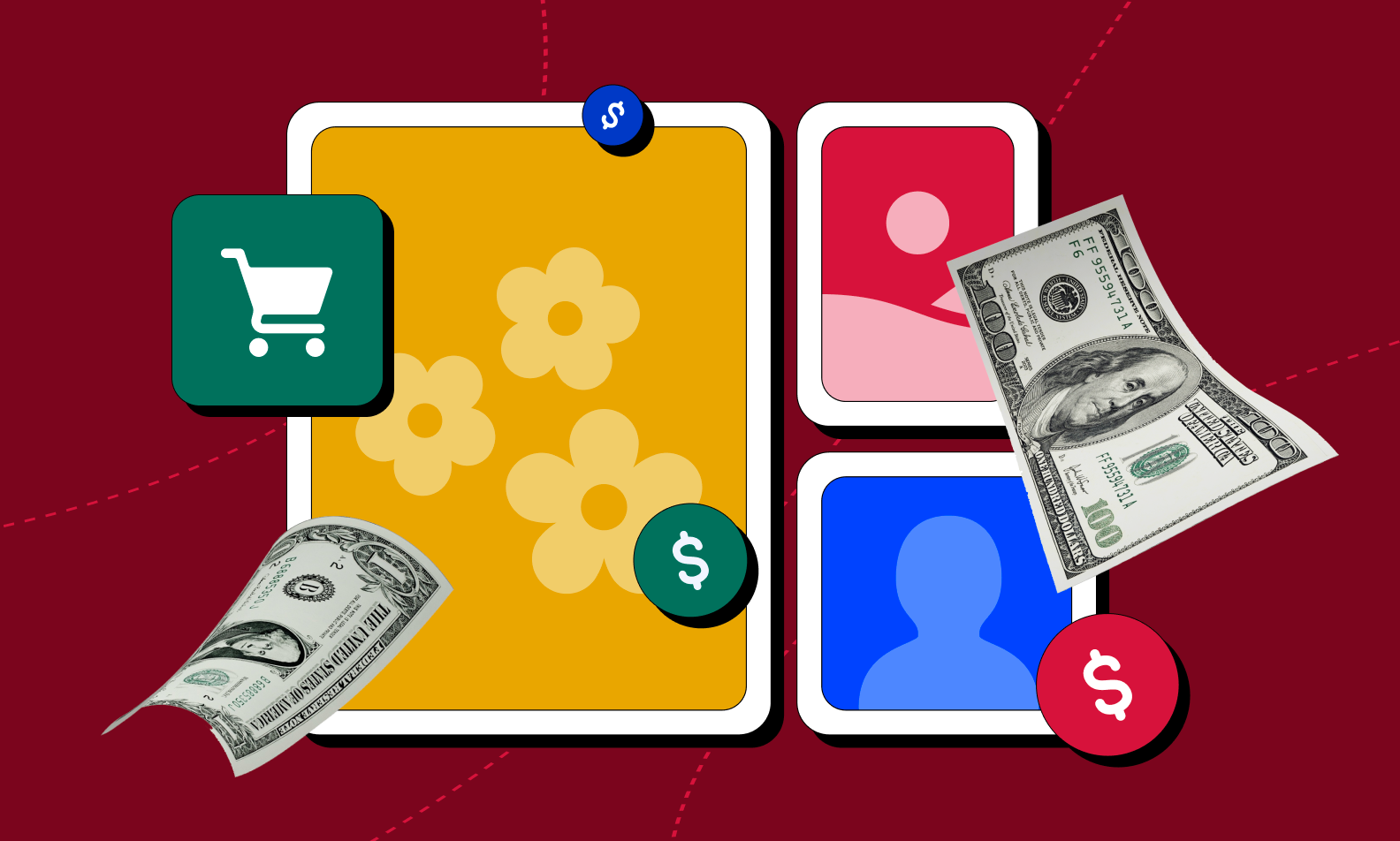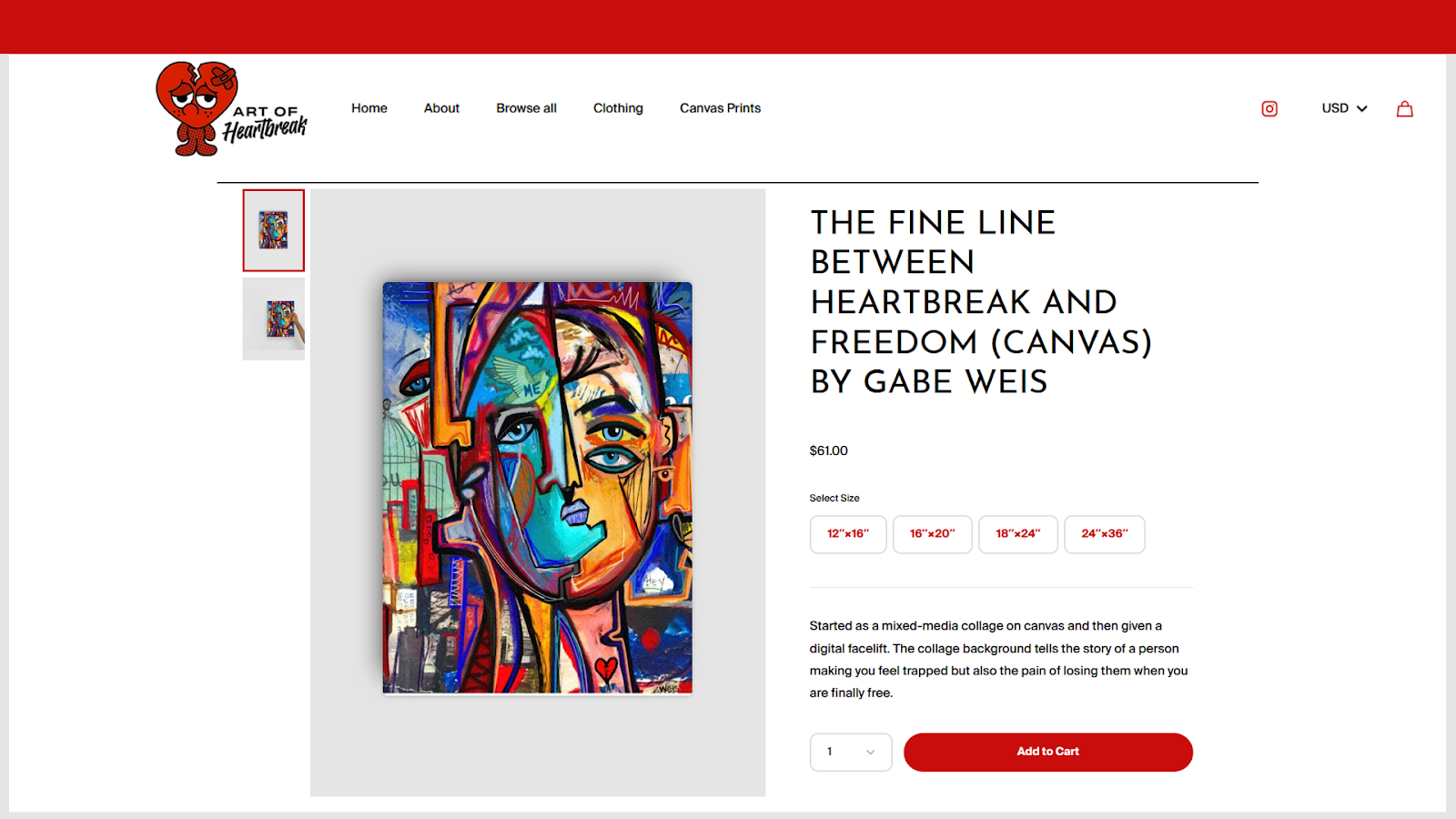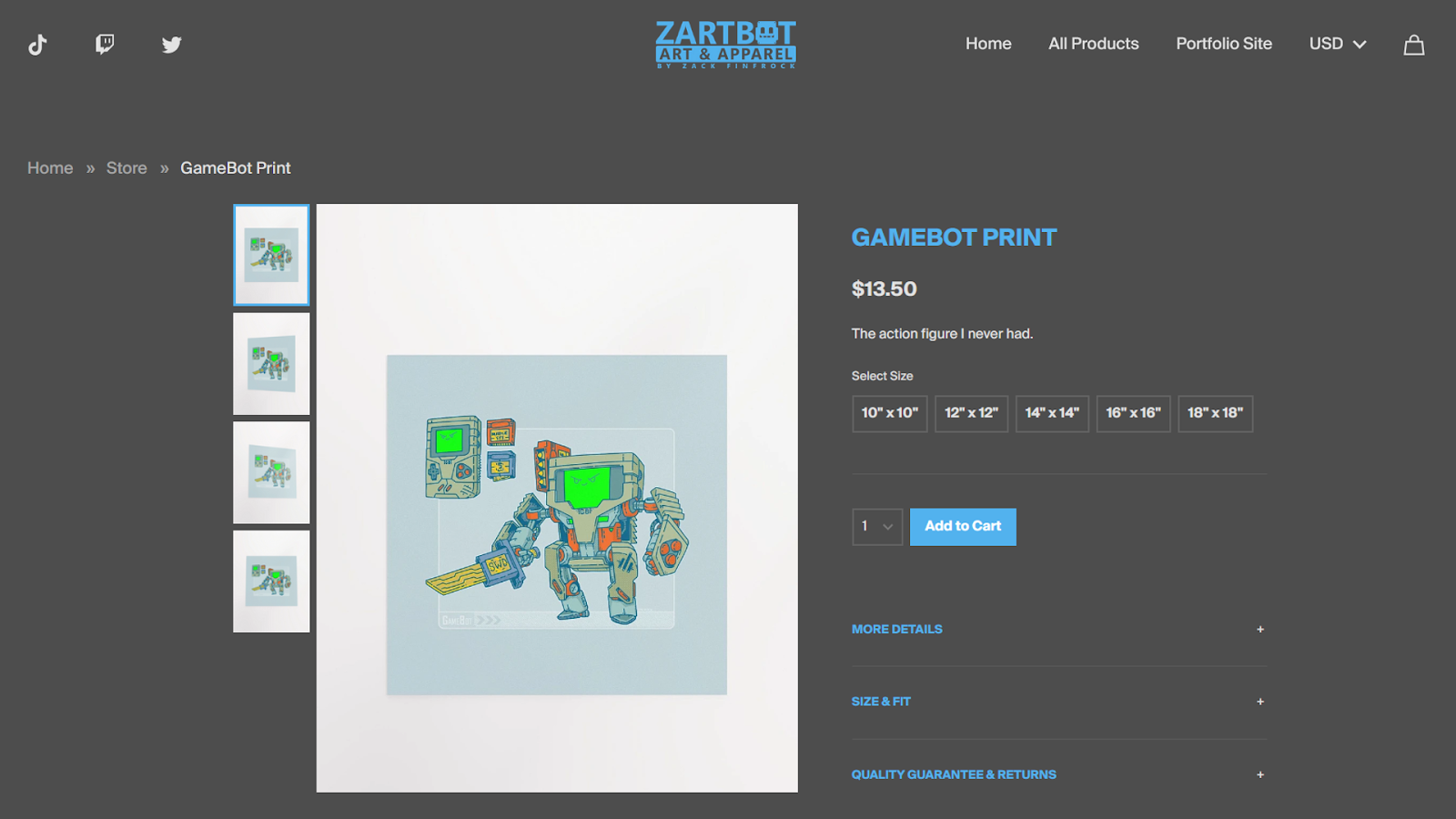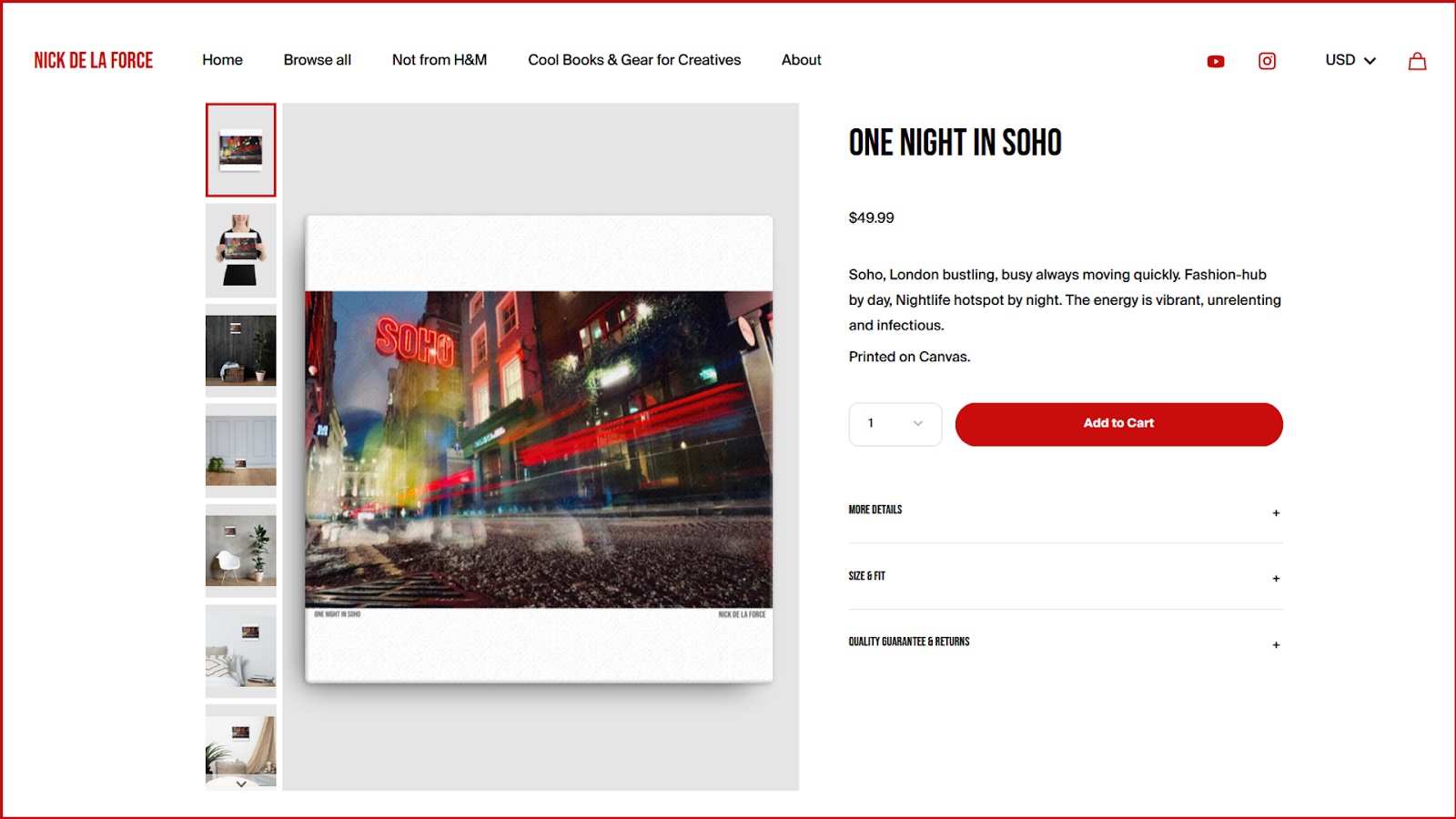How To Make Money Selling Art Online

Selling art online in the global online art market is becoming more and more popular, with artists raking in over $12 billion dollars as of 2024. And the best part of this for artists in general? It's projected to keep on growing, as more and more people are shopping for art online, with over 50% of them discovering new artists on sites like Fourthwall, Saatchi Art, Etsy, and Fine Art America - and 60% of these art lovers are using their mobile devices to find artworks to purchase!
It's pretty clear to see how this is excellent news for artists, with the doors flung wide open to opportunities for you to sell art online. Whether you're a career artist or just taking your first steps into the world of selling art, we've got the info and the tools for you, so you can learn how to grow your fan base, price your products, and sell art online. By the end of this blog, you'll have all the keys to building your thriving online art business - so let's go!
Making Money Selling Art Online: Is It Realistic?
There's a common misconception that only established artists like those showcased on sites like Fine Art America or Saatchi Art can be successful selling art online. But online art platforms have actually helped democratize the art market, making it more accessible to a wider range of both artists and art buyers. While Fine Art America and Saatchi Art are still solid headquarters for established artist names, sites like Artfinder are giving emerging artists with unique styles the opportunity to build their own followings and sell art online.
The next key is to treat your online art sales as a business. Once you have the artworks completed that you want to sell, you need to plan your approach, strategically market your work, and provide top-notch customer services to build trust with potential buyers as you build your fan base. With appealing art, a well-defined strategy, and consistent effort, online art sales can become a steady and fulfilling revenue stream for you as an artist!
Physical Art or Digital Art?
The decision to sell physical art, print on demand digital art, or both is an individual choice, but there are definitely benefits to each. Selling physical art, like paintings, framed sketches, or numbered and signed art prints, allows your fans and art collectors the opportunity to own a tangible, original piece of your work, which adds to your work's exclusivity and can allow for higher price points. Physical artworks, however, do require additional considerations - shipping logistics/costs, framing, and production costs (for high-quality prints) among them.
Selling print on demand digital art eliminates those extra costs, and also allows your fans to download your work instantly (with the printing and framing being done on the customer's side.) Digital art print on demand products can also stretch beyond wall art prints, and can include such additional digital art creations as story/article illustrations, stock photography, or, on a more informal note, uniquely designed printables.
Unlocking this decision simply requires you to think about the type of art you create, your target audience's preferences, and if it's worth it to you to invest the time and effort into fulfilling physical product orders, or if you prefer to sell artwork online in digital form only. Many artists choose both - selling exclusive physical art pieces, and also offering print-on-demand items that can span the bridge between both types of art collectors. You just need to find the niche that aligns with your artistic voice and the kind of art business you want to have. Using a platform, like Fourthwall, will allow you the flexibility to offer both physical and digital products. There's no “right” answer. Again, it's a very individual decision per artist, but this is definitely an important consideration to decide upon before our next steps: putting together the rest of your art sales business plan!
How to Sell Art Online in 8 Steps
1. Create Your Showcase
Before you dig into the business side of your new art venture to start selling art online, you should make a curated online portfolio that showcases your best and most visually appealing work! You could do this on a dedicated website for your art; an artist profile on an online marketplace or ecommerce site; or a combination of both.
When creating your portfolio, make sure the images of your art are high-quality, and that each listing includes a clear, interesting description of each artwork, sharing the work's name, the story behind it, and perhaps your inspiration in creating it. All of this helps potential buyers connect with your art on a deeper level, which can lead to both fans and sales

2. Choose Your Platform
Check out the various online marketplaces and ecommerce platforms that cater to artists, to decide where you'll be selling art online. As mentioned earlier, if you're already a well-known, established artist, you can list your original artwork on sites like Saatchi Art and Fine Art America; but whatever stage you're at in your art career, there are places for every type of art and artist online!
One great choice that gives you all the control over selling artwork online is Fourthwall. You can establish your own gallery shop, sell artwork, easily set up print on demand wall art prints, and even create custom merchandise with your art on it! Selling art directly to your customers via sites like Fourthwall, Society6, or Etsy is such a good way to get established; just make sure you're researching factors like your audience demographics, website integrations, marketing and analytics tools, and any commission fees that these sites might require.

3. Set Your Prices
Pricing your art is something of a balancing act. If you're selling physical pieces, make sure you factor in the time you've invested in concepting and creating your original artwork (don't undervalue yourself!), as well as the more obvious costs of framing, packing, and shipping, and the production costs of prints, if you choose to make those.
Time investment also matters in regards to your digital print on demand artworks; the difference here being that you can create a single painting or drawing, and reproduce it multiple times as an art print, so you may be safe pricing these lower, as repeat sales can help make up the difference. You can also research similar artworks on the marketplace to determine a competitive price point - but stay mindful of both what your work deserves, and what you think your target audience will be willing to pay.

4. Optimize Your Presence
SEO (Search Engine Optimization) can really help amplify your online art sales. When creating the listings for your artwork, make sure to research relevant keywords that describe your art style and each individual piece, and incorporate those keywords strategically in your titles, descriptions, and tags. This will help increase your online visibility and and give your artwork a better chance of reaching the right audience!
5. Promote Your Art
Don't wait for buyers to find you! While creating great images and descriptions and maxing your SEO can help make your artwork more visible, you don't necessarily have to sit around waiting for art buyers to discover you selling art online.
Leverage your social media accounts like Instagram and Tiktok by posting striking images of your artwork, and perhaps sharing some trivia about each piece, or stories about your creative process. Try collaborating with online art communities, to share your original art with fellow creators and art collectors. And once you start selling art online, whether it's on Fourthwall, Etsy, Artfinder, or another platform, use email marketing to keep your fans up to date on your newest artworks and where they can find them. Using the power of social media can really help you build a dedicated following.
6. Value Your Customers
As with any business, treating your customers/fans well and building trust with them is important to the success of you selling art online. Respond promptly to questions about your artwork, provide clear shipping/fulfillment information for physical artworks, and just offer exceptional customer service overall. A positive buying experience will help encourage repeat customers and continue building your fan base of art lovers - and don't underestimate the strength of word-of-mouth recommendations for your art!

7. Analyze and Improve
You can identify areas for improvement as you go by keeping track of your analytics. As you sell your art, be sure to monitor your website/shop traffic, analyze the sales data for each piece of art, and gather customer feedback where it's appropriate. Studying this information can help adapt your business strategy, you need to rewrite your art descriptions, take better photos of your artworks, or improve your SEO. You can also keep an eye on which of your social media platforms are driving more traffic to your site, and adjust your posts accordingly.
And it's not all about just selling art - staying on top of the art world as a whole is also beneficial. Get inspired along your art journey by checking out new art techniques, attending online art workshops, and following other artists on platforms like Artfinder to see how your peers are creating and promoting their own original artwork.
8. Be Patient!
Don't get discouraged if sales and growth aren't immediate - selling artwork online and building a successful online art business takes time and dedication. Whether physical art or print on demand digital art, your focus should be on consistently creating high-quality work, engaging with your audience, and refining your marketing and socials strategies. Committing to your new art business, learning and adjusting as you go, and staying positive are the rest of the keys to your long-term success.
Ready to Sell Your Art Online? Fourthwall Makes it Easy!
Now that you've got a full key ring of tools for unlocking the world of online art sales, it's time to bring Fourthwall into the mix! Fourthwall empowers artists by providing a comprehensive platform for selling art online and managing everything else, too - your own custom website, online store, social integrations, and so much more!
With Fourthwall, you can easily set up your online storefront with customized branding, layout, and art listings to showcase your original art and other products featuring your artwork. You can even sell art as high-quality prints through Fourthwall's print on demand service! In addition, you can sell memberships to fans of your art, offering exclusives like limited-edition prints, art tutorials, or behind-the-scenes peeks at your creative process. Fourthwall is a great place to sell art online and to manage your entire online art business from a single location - get started today!
















